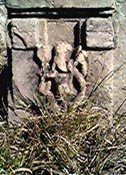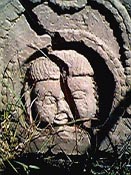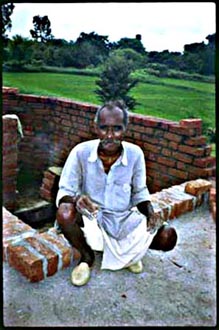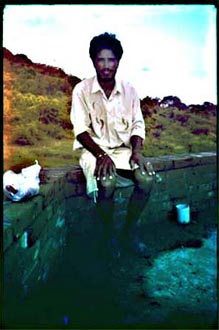  The Story of
Beti Maia The Story of
Beti Maia
A very long time ago, a small community of oil-millers lived
in a village set just across from what now is the northern boundary
of The Last Resort. The ruins of this village and it's
temples can still be seen at the base of the hill by the riverside
ó with Sati stones, hero stones, and stone temple-elements
including fragments of exquisite statuary litterred about (some
dated back a thousand years and more).
It is locally said of this village that it was named "Hastinapur",
and many years ago there lived here a very special young girl,
of such comely form and disposition that all in the village fondly
knew her as "Beti" (daughter). When the time came for
this popular young lass to be wed, it was therefore only natural
that all of the villagers got enthusiastically involved beyond
that special camaraderie common to all true villages which so
often prompts such joint-endeavour to great effect, in assembling
an appropriately high-spirited affair that people from miles
all around were invited to attend.
On the fateful day, however, while the entourage of the dashing
groom chosen from such a vast array of ready prospects in villages
all around, as the most outstanding candidate on all counts,
was excitedly awaited by hundreds of people,.. neither hide nor
hair of it was seen or heard of for hours after a delay could
still have been forgiven in the normal course, and even until
our lassie's honour and Hastinapur's prestige itself were eventually
at stake!
To be stood up at the altar was ridiculous for such a fair catch,
and with eager prospects still at hand on all sides, a fresh
groom was then chosen and dispatched home to prepare himself
and return.
Now, I'm not certain why the original groom was delayed in the
first place, ó and there certainly are different versions
of this story, ó but as the second groom and his quickly-assembled
entourage returned through the forest towards Beti's village,
along came the first groom on the same course with his
retinue.
Not surprisingly, angry words were soon exchanged between the
two groups. This then quickly degenerated into a brawl with much
sorcery excercised in the melee,.. and in the end, many lay dead
or dying, with both grooms turned to stone!
When word of the tragedy reached our little village, all were
aghast and agog, with a considerable hullabaloo and lots of confused
discussion and general running about reigning for several hours.
And in the general hubub, none but her closest companions (who
rushed after her, and later told this tale) noticed Beti flee
the village upon hearing the news, climb to the top of the hill,
take one last look all around her, and then abruptly immolate
herself on the spot with the powerful magic of her extraordinary
grief.
As can be seen from the Sati stones still lying about, it was
a time, a place, and a community that sometimes saw widows immolate
themselves on their husbands' funeral pyres, when the latter
died. In the ancient hindu traditions this belonged with, such
"Satis" were highly regarded in certain quarters
as manifestations of the Mother Goddess (Ma, or Maia,
from whom all Hindu Goddesses are drawn), and their final passages
were often memorialized in Sati stones, and sometimes a temple.
In line with this, Beti came to be worshipped by the people of
the area in time as "Beti Maia" in a handsome stone
temple built atop the hill to honour her. In the course of centuries
of great wars and movements of mighty armies through the area
since then, however, this temple was completely reduced to rubble
at some lost point in time.
Today, Beti Maia is still popularly revered and worshipped in
various ways by the people of Hatod and many others, at a spot
on the hill-top where beautiful fragments of stone-statuary from
the lost temple have been gathered into a small heap over the
years. Many of the folks in the neighborhood claim to even hear
the sound of horses, anklets, and music coming from this spot
in the nights before and after certain festivals.
Bati Maia is said to be profoundly benevolent to all who approach
her, and to sometimes possess certain local people to communicate
with her followers through them. The wife of our sharecropper,
Maiya, is spoken of as one of these mediums, but though she is
a remarkable lady in very many ways, she's never called Beti
Maia for me.
*
|
The
Nearest Buried Treasure

Just across the canal from the remains of Beti Maia's village,
Hastinapur, towards the river near our northern boundary, lie
the exquisitely sculpted stone ruins of a thousand year old temple
and stone canopy (chhatri), neatly arranged in a circle
around a pit. Unlike Beti Maia's temple on the hill-top, the
destruction of these are relatively pinpointed in time ó
to about 1990!
Buried and hidden treasures are not unknown to Shivpuri District,
and the usual backgrounds (through centuries of invasions, unrest,
battles, banditry, and wars) seem straightforward enough, e.g.,
Man buries savings before going to war... Never returns
or
Family buries savings as war comes to village... None survive
From rumours and record, it is clear that such treasures do
turn up from time to time in varying measures. However, there
are also said to be other sorts of treasures, including the lost
booties of certain kings and great rogues,.. and various riddlesome
rewards locked in mystic old codes.
Of recent cases from amongst the last, a report quite broadly
bandied about in the region has it that some lucky fellow cracked
such a code at a temple in the haunted Narwar Fort (40 km north
of us), and turned up a quite considerable fortune as a result
of this less than ten years ago. The story goes that the key
to the riddle eventually had to do with identifying two brothers
mentioned in an ancient engraved text on a massive rock (key-stone?)
at the temple, with a couple of stone statues standing nearby.
This is hearsay, of course, not a case of public record. But
in defence of granting some little credence to such stories,
it must be said that few true findings are actually reported,
since the government is entitled to the lion's share in all cases.
To return to our story however, it is said of the ruined temple
mentioned at the beginning, that when it still stood with the
comparatively humble chhatri beside it just ten years ago, a
large rock-element of it's base bore an enigmatic and titillating
engraved text embellished with what seemed to be a corroborative
relief sculpture.
In sum, the text is said to have spoken of seven mule-loads of
treasure buried somewhere nearby, awaiting the coming of one
who would "sacrifice his first son and daughter-in-law
for it" (the riddlesome part). While the original of
this text no longer exists, those who claim to have seen it at
some point in time insist that it was chipped away when the temple
was brought down (but that rubbings were first taken). For the
record, my own personal impression of the stone today is that
it certainly is possible that something was recently chipped
away from a particular blank panel about a foot square.
Above this space, however, are three panels undamaged beyond
the weathering of centuries. The topmost of these bears the straightforward
bust of a crowned gentleman with large dangling earrings. The
panel below this has a seated male figure flanked by two female
attendants, portrayed full-length, and the last (just above the
blank one), which is understood to be the most crucial image
in the context of our story, has the form of a crowned gentleman
laid on his side, with seven "mules" over him.
Of course, all of this is as riddlesome as it gets, but centuries
of compulsive treasure- hunting in the area has conjured a good
number of extraordinary alternatives on approaches to such matters.
The best known of these methods is as complex as could be expected,
proceeding from the twin local beliefs that (a) men born-feet-first
have very special powers indeed in such matters, and (b) "Tantriks"
in the fringes of hindu practice everywhere have command over
indescribably potent rituals and necromancy.
With the destruction of our little lost temple, the sequence
of events is said to have proceeded as follows:
About ten years ago, three friends in the neighborhood got together
to unearth the treasure apparently locked in the obscure temple
riddle.
The three first won a tantrik of great repute to their cause,
and with him shortly combed the district to find an appropriate
man born-feet-first to begin the search for their treasure. When
this was done, the tantrik then began preparing both himself
and this man for the very special task ahead.
At first, a lot of ritual had obviously to be gone through to
propitiate the gods and the spirits. And then, a particular type
of serpent was hunted out, carefully captured, ritually sacrificed,
and burnt. The ashes from this were scrupulously gathered, smoothed
into a paste with butter-oil, and finally applied to the eyes
of the man born- feet-first ó who had been prepared for
his job in various other ways too.
The man ostensibly now had the power to look anywhere into the
very earth and clearly see everything that was there!.. and sure
enough, he spotted the treasure before very long, directly under
the temple itself!!
I wouldn't care to image the dilemma this presented to the three
partners, for till this point their intent, and their activities
in pursuit of this, ó however wierd they may seem to some,
ó had been entirely acceptable.
At any rate, a hard decision had now to be taken, and with seven
mule-loads of treasure actually "spotted", the temptation
was surely too great.
Accordingly, a day was set to proceed on this intelligence. Loyal
strong-arm-lads were recruited and armed to stand sentinel in
the forests on all sides. Others were recruited and equipped
for the actual labour. A powerful tractor with chains and pulley
was commandeered. The tantrik went through impressive rituals
to protect all involved, and even have the very gods stand aside...
.. and then, the temple and the chhatri were methodically pulled
down over two days, with the huge stones used in their construction
all dragged well away from the spot where the treasure had been
"seen" beneath the earth ó thus forming the
circle of scatterred constuction-elements we see today.
Frenzied digging was begun as soon as the space where the temple
had stood was cleared.... but this just went deeper and deeper
to obviously unlikely limits without turning up a thing!
The tantrik and the man born-feet-first were called to account
and roundly abused and berated, but continued to insist that
the treasure was within grasping distance, and urged that the
work go on. And so, another hole was dug next to the first, and
another, and another,.. and still none yeilded a thing!!
Eventually, after several days, the whole effort was at last
given up, although the three original partners were still held
firmly in the grip of their fantasy, and the story was still
far from over.
In time, the entire blame for the no-show in this incident came
to be placed upon the man born-feet-first,.. and so the tantrik
then turned up another, to begin all over once again.
This time, the focus fell upon what is now a part of The Last
Resort.......
Amongst evidence held as "proof" that the people of
Beti Maia's village were oil- millers, are a good number of large
rock-mortars scatterred through our little forest. These "kolus"
are cylindrical obelisks about five to seven feet in length by
about three feet in diameter, tapered towards one end with a
large hole excavated in the other. They were buried in the earth
with the latter end sticking up a foot or two, and milling was
conducted by putting teams of oxen to work turning large wooden
pestles in the hole. Stock was fed into the top and the juice/oil
flowed out from a channel cut in the rock-lip, while waste was
evicted from a smaller hole in the side.
Some folks in the Shivpuri area however insist that the kolus
were actually used to juice sugar-cane, which I think
quite likely.
Be that as it may, with the help of the new gentleman born-feet-first,
our three partners and their friendly tantrik went to work,..
and this time, the treasure was spotted right underneath the
largest kolu on our site!
Once again, guards were mounted on the hill, labour was marshalled,
the tractor was brought to hand, powerful rituals were enacted,
and all set to work. The earth around the base of the kolu was
first dug up to free it, and then a chain from the tractor was
locked around the top of the rock to lend to all the heaving,
pushing, and pulling of the labour, as the kolu was excavated.
Reports have it that this time, our friends did indeed turn up
something ~ as it happens, a very large black snake no less!
There was immediate panic, and it only got worse when some of
the more strong-hearted amongst those present readied to kill
the snake, for the tantrik then suddenly hysterically started
screaming that he too would die with it!!
In the end, all fled the scene and the three main partners reportedly
went stark raving "mad" as a result, for a full year.
One partner died in this period. A second recovered fully and
put the entire incident and ambition firmly behind himself. The
third partner is however said to have persevered off and on with
his search through the years, and is still said to sometimes
surreptitiously prowl around the area at night, in the company
of an ever-changing array of tantriks and men born-feet-first.
He is said to have been the prime-mover in the entire story,
who could never again sleep in his house of that time,.. from
which he then moved a kilometer away into a simple hut, in which
he lived for the next three years before making a house again.
The story finally went "public" in a local vernacular
newspaper some years later (1996), and a minor enquiry was conducted
by local authorities. The matter has not moved further since.
It should perhaps be kept in mind here that such events are by
no means rare to Shivpuri district. Amongst uncounted contemporary
examples, a gentleman farmer is widely reputed to have completely
dissassembled a small but ancient fortress on his land (about
10 kms east of us) over several years, leaving not one sign of
it to be seen today. Having turned up nothing as yet in the bargain,
however, his search too still continues. Meanwhile, the fascinating
Paragarh Fort (the "Fort of Mercury", about 40 kms
south-east of us) is gradually being reduced with a multiplicity
of separate ongoing treasure-hunts.
From all of this, it would seem entirely possible that a lot
of the destruction of temples and other noble edifices that once
stood across this land can probably be ascribed to such treasure-hunting
(which continues today), rather than to the mindless actions
of marauding armies.
Today, the land the temple stood upon belongs to my good
friend Ajit Singh, who is working towards reassembling the edifice.
* |
 Maiya's Testimony
Amongst the more prominent totems to people long gone
in our area, are two "Thakur Baba" platforms ó
to the south and north-west of us. Thakurs were the warrior
castes in certain parts of old India, and these two platforms
certainly memorialize particular old heroes (claimed by some
to be associated with the story of Beti Maia). Maiya's Testimony
Amongst the more prominent totems to people long gone
in our area, are two "Thakur Baba" platforms ó
to the south and north-west of us. Thakurs were the warrior
castes in certain parts of old India, and these two platforms
certainly memorialize particular old heroes (claimed by some
to be associated with the story of Beti Maia).
As with the site of Beti Maia's temple on the hill, unexplained
sounds are said to be often heard at these places on certain
special nights.
Our sharecropper has been living in The Last Resort for
the last several years, and when I once asked him about these
stories, he unhesitatingly claimed to have heard the sounds himself
on several occasions.
When I then asked him whether he had actually ever seen anything
extraordinary to go with this, he professed to have indeed once
witnessed a white-robed and turbanned gentleman astride a white
horse emerge from our forest, proceed towards the platform to
our south,.. and disappear!
epilogue (January 1998): Some months after he told me
this, Maiya's little grand-daughter, Kiran, apparently drew the
gaze of several people to a similar vision on an entirely separate
occasion.
*
|
 Harjeet's Bad Dreams
Once upon a time, while walking through the forest
from a friend's farm back towards The Last Resort, I spotted
an extremely handsome top-segment of a sati stone beneath some
bushes near the ruins of Beti Maia's old village, Hastinapur.
When I later met Harjeet, our caretaker, I instructed him without
thinking over the matter properly, to fetch this stone to our
site so we could put it up properly somewhere, as a sort of "decoration". Harjeet's Bad Dreams
Once upon a time, while walking through the forest
from a friend's farm back towards The Last Resort, I spotted
an extremely handsome top-segment of a sati stone beneath some
bushes near the ruins of Beti Maia's old village, Hastinapur.
When I later met Harjeet, our caretaker, I instructed him without
thinking over the matter properly, to fetch this stone to our
site so we could put it up properly somewhere, as a sort of "decoration".
Since the stone was rather large, this was put off for the next
day.
That night, I was beset with disturbing dreams I do not remember,
but upon awakening the next morning, my first move for some reason
was to find Harjeet and withdraw my instructions.
As I arrived (having slept elsewhere), the first thing I saw
was Harjeet emerging from the forest with two young lads together
carrying the stone upon their shoulders. I could obviously do
nothing but congratulate them on their effort, and the stone
was carefully set aside to be attended to later.
Some days after this, Harjeet took me aside, apologised for what
he wished to say and then confided that he had been haunted by
bad dreams and ill-health since we had brought the stone over,
and that something about it kept prompting him to return "her"
to her mother, her father, and her family.
When he sought permission to return the stone to where we had
found it, I unhesitatingly granted this,.. but in the event,
Harjeet actually had the stone carried back to a new location
at the base of a tree in our forest, a short distance from where
it had lain before.
He seemed to prefer it there, and there it has stayed (upon a
small stone platform we've had made for it).
... I can only hope that she too is now happy.
epilogue (January 1998): The story has a "happy"
ending of sorts, in that several months after we moved this stone,
a local farmer gathered up and carried off quite a bit of the
rubble of Hastinapur, to use for a minor land-fill in his yard...
no end to the craziness!
*
|
{texts by Shankar Barua ~ 1995} |

